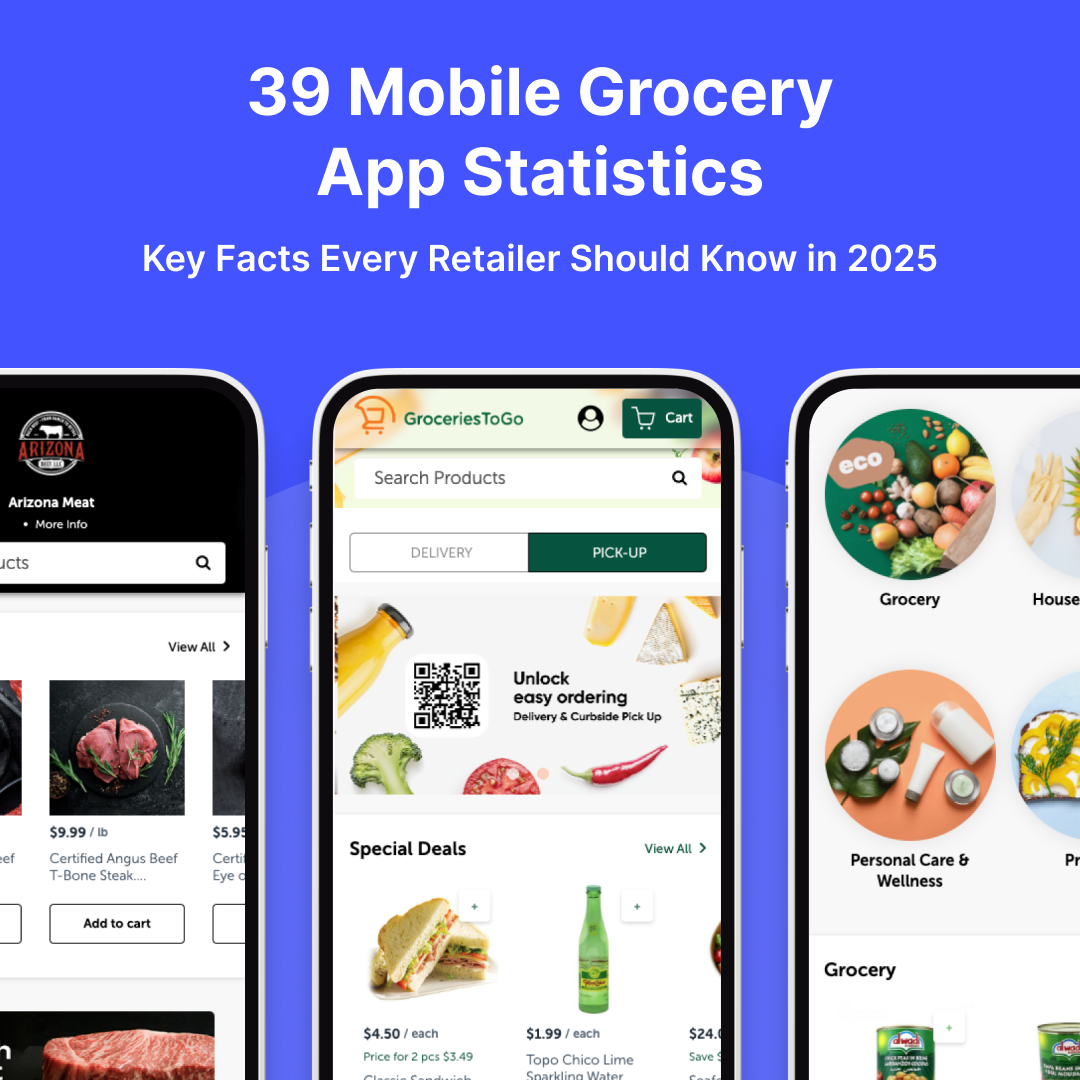


Comprehensive data compiled from extensive research on digital grocery transformation and mobile commerce
The global online grocery market was valued at $67.64 billion in 2024 and is expected to reach $80.83 billion by 2025. Long-term projections show continued expansion, with the market potentially reaching hundreds of billions by the early 2030s. This represents fundamental transformation in how consumers purchase food globally. Source: Grand View Research - Online Grocery Market
Over half of US adults (51.8%) now purchase groceries online, totaling approximately 148 million active users. Mobile apps and websites combined generate substantial digital sales, with mobile representing the majority of online grocery traffic. This mobile-first behavior creates opportunities for retailers to reach digitally-native customers. Source: Capital One Shopping - Online Grocery Statistics 2025
The United States online grocery market is experiencing robust growth, with sales reaching over $200 billion and maintaining double-digit annual expansion. This growth rate significantly exceeds traditional grocery sales, indicating a permanent channel shift rather than temporary behavior. Source: eMarketer - US Digital Grocery 2024
Industry projections suggest online grocery penetration will continue growing from current levels of approximately 12% to potentially 20% or higher by the late 2020s. This transformation represents decades of typical retail evolution compressed into less than a decade. Source: McKinsey - The Next Horizon for Grocery E-commerce
Mobile devices account for approximately 60% of fast-moving consumer goods e-commerce traffic globally. This mobile-first reality is expected to continue growing, making mobile optimization essential for grocery retailers. Asia-Pacific leads with the highest mobile adoption rates while commanding a significant portion of the global market. Source: Euromonitor - FMCG E-commerce Growth
Millennials lead digital grocery adoption with 86% using mobile apps and websites for food shopping, establishing behaviors that influence other demographics. This generation values convenience, sustainability, and supporting local businesses. Their median age places them in peak earning years, making them valuable long-term customers. Source: Statista - US Online Grocery Buyers by Generation
Families with children under 18 demonstrate substantially higher online grocery usage, being 168% more likely to shop online compared to households without children. About 43% of parents regularly use digital grocery platforms, driven by time constraints and the logistics of shopping with young children. Source: Drive Research - Online Grocery Shopping Statistics
Mobile and online grocery transactions show substantial economic advantages, averaging $112-174 per order compared to approximately $43 for typical in-store purchases. This represents a 160-300% premium, reflecting consumers consolidating multiple trips into single weekly orders. Source: Capital One Shopping - Online Grocery Statistics
About 40% of mobile grocery users order weekly, and customers who maintain weekly engagement show strong long-term retention. This frequency represents valuable customer loyalty - predictable, high-value, repeat purchases that significantly exceed typical app retention rates. Source: Wave Grocery - Online Shopping Statistics 2024
The customer journey shows progressive retention improvement: 27% of first-time mobile grocery buyers return, increasing to 49% after the second purchase and 62% after the third. This progression emphasizes the importance of the initial experience and service quality. Source: Capital One Shopping - Grocery Shopping Trends
Gen Z shows 83% mobile grocery adoption with compressed delivery expectations - significant percentages expect groceries within one hour of ordering. This generation applies on-demand expectations across all services and is entering household formation years with these preferences established. Source: PYMNTS - Gen X Leads Mobile Adoption
While Boomers currently show 25% regular mobile grocery usage, they represent rapid growth with significant year-over-year adoption increases. With substantial disposable income and growing comfort with technology, this demographic offers significant opportunities for retailers. Source: Statista - Baby Boomer Mobile App Use
The 35-54 year-old age group represents 41% of monthly online grocery shoppers. This cohort balances career peaks with family responsibilities, making convenience a priority. Their high lifetime values make them attractive targets for acquisition strategies. Source: Capital One Shopping - Demographic Analysis
Metropolitan areas demonstrate mature mobile grocery markets with 60% of urban residents using delivery services and 25% shopping online weekly. This concentration enables efficient delivery economics while busy urban lifestyles prioritize convenience. Source: Grocery Dive - Urban Shoppers Drive Growth
Rural communities show lower mobile grocery adoption despite widespread delivery availability. Infrastructure limitations, including broadband access, create opportunities for hybrid models combining phone orders with app-based systems. Source: Brookings - Delivering to Deserts
The Asia-Pacific region commands the largest share of global mobile grocery commerce with extremely high mobile penetration rates of 86-90% for transactions. China alone shows substantial e-commerce app penetration with sales exceeding $200 billion by 2025. Source: Grand View Research - Online Grocery Market
European adoption varies dramatically by country: Netherlands achieves 35% online grocery penetration, UK reaches 32%, while France emphasizes click-and-collect with 90% choosing pickup over delivery. These differences reflect cultural preferences and infrastructure. Source: Statista - European Online Grocery Market
China's mobile-first grocery market demonstrates what's possible when infrastructure, adoption, and innovation align. With high e-commerce app usage, mobile grocery represents mainstream consumer behavior rather than a niche market. Source: Statista - China Shopping Apps Penetration
Suburban areas show lower delivery adoption compared to urban centers despite higher incomes. This gap reflects established shopping habits rather than economic barriers, creating opportunities for platforms emphasizing convenience and local relationships. Source: Grocery Dive - Urban vs Suburban Patterns
Digital food access reaches 90% of areas, including lower-income neighborhoods. However, delivery fees and minimum orders can create barriers. Government programs increasingly support digital payment for benefits programs, expanding addressable markets. Source: Brookings - Digital Food Access
41% of shoppers expect grocery delivery within 24 hours of ordering, with 24% demanding 2-hour windows. This acceleration favors hyperlocal fulfillment where neighborhood stores hold advantages over centralized warehouses. Source: Roadie - Delivery Statistics 2024
76% of Americans pay for grocery delivery services. About 23% expect to pay $5-6.99 per delivery, while 46% will pay premiums for same-day service. This payment acceptance validates the convenience value proposition. Source: Attest - Grocery Delivery Research
Fulfillment preferences favor maximum convenience, with 63% preferring home delivery versus 37% choosing click-and-collect. This trend benefits platforms enabling stores to offer delivery without building logistics infrastructure. Source: ECDB - Consumer Delivery Expectations
Despite convenience focus, 47% of global consumers actively prefer locally-owned businesses, with 21% specifically shopping at independent grocers online. This preference extends beyond price to include trust, community support, and unique product selection. Source: McKinsey - State of Consumer 2025
Research shows 70-91% report satisfaction with delivered grocery freshness, though 51% remain frustrated by substitutions when items are unavailable. Local stores' expertise in product selection provides competitive advantages over automated fulfillment. Source: MeasuringU - Grocery Benchmarks 2022
Artificial intelligence transforms mobile grocery economics through personalization, delivering improved conversion rates when properly implemented. AI-powered recommendations also drive basket increases by suggesting complementary items based on purchase patterns. Source: McKinsey - The Real Value of AI in CPG
49% of Americans use voice search for shopping, with 44% of smart speaker owners ordering groceries weekly through voice commands. The global voice shopping market continues growing, supported by billions of digital assistants. Source: Capital One Shopping
Payment evolution accelerates with 16% of Americans using smartphones for everyday purchases and mobile wallets growing steadily. This shift toward contactless payment reduces friction while enabling features like automatic loyalty points. Source: Statista - Digital Payments Forecast
Artificial intelligence adoption reaches high levels among retailers for personalization and optimization. Benefits include improved forecast accuracy, shortage reduction, and inventory optimization. These capabilities help level the playing field for smaller retailers. Source: McKinsey - AI Transformation in Retail
Digital grocery faces escalating acquisition challenges, with costs varying significantly by market and strategy. This emphasizes the importance of retention and the advantages of platforms that leverage existing store relationships. Source: L.E.K. Consulting - Rising CAC Costs
Retention challenges affect mobile apps generally, with most losing users quickly. However, grocery apps that create weekly engagement habits show much stronger long-term retention, highlighting the importance of regular use patterns. Source: Nudge - Mobile App Retention Stats
Comprehensive digital transformation generates substantial EBITDA improvements for food companies. Retail media opportunities also deliver high gross margins, creating additional revenue streams for digitally-enabled retailers. Source: McKinsey - Digital & AI Transformation Value
Mobile-optimized experiences significantly outperform desktop alternatives. This mobile advantage benefits platforms designed mobile-first, where simplified interfaces and one-touch reordering reduce friction for consumers. Source: MyTotalRetail - Power of Mobile Apps
New grocery platforms typically require extended timeframes to achieve profitability, with comprehensive digital transformation taking time to optimize. This timeline favors partnerships where stores leverage existing platforms rather than building proprietary solutions. Source: LoyaltyLion - E-commerce Economics
Small and independent grocers experience growth through platform partnerships, with many reporting revenue increases from delivery services. This growth comes without infrastructure investment as platforms handle technology and logistics. Source: Business and Tech - Small Business Revenue Boost
Platform partnerships generate employment opportunities at small grocers, with services like Instacart creating jobs throughout the industry. This represents significant job creation beyond what traditional growth might provide. Source: Coolest Gadgets - Instacart Statistics
Mobile grocery ordering can deliver environmental benefits, with research showing delivery reducing emissions by 20-75% compared to individual shopping trips. The variation depends on route density, vehicle efficiency, and optimization strategies. Source: University of Washington - Grocery Delivery Carbon Impact
Online ordering can help reduce food waste through better planning and portion control. Digital platforms enable more precise ordering, helping both stores and consumers minimize waste while addressing the reality that food waste contributes significantly to global emissions. Source: WSU - Food Waste Impact Study
Economic and time benefits prove substantial for families using digital grocery platforms. Consumers report meaningful time savings and often cost reductions through better planning and reduced impulse purchases. These quality-of-life improvements make digital grocery shopping sticky for adopters. Source: Wave Grocery - Household Benefits Data

